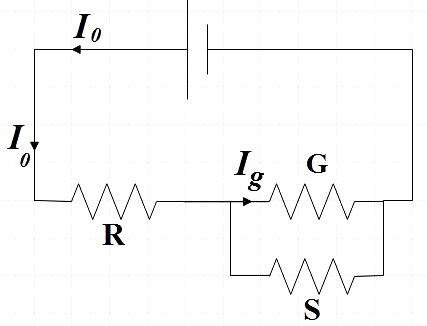
In a circuit for finding the resistance of a galvanometer by half deflection method, a 6V battery and a high resistance of $11k\Omega $ are used. The figure of merit of the galvanometer is$60\mu A/division$. In the absence of shunt resistance, the galvanometer produces a deflection of $\theta =9divisions$ when current flows in the circuit. The value of the shunt resistance that can cause the deflection of $\dfrac{\theta }{2}$, is closest to
A. $55\Omega $
B. $110\Omega $
C. $220\Omega $
D. $550\Omega $
Answer
555.6k+ views
Hint: From the given figure of merit we get the current passing through the galvanometer when it shows deflection of 1 division, multiplying this with $\theta =9$ gives the current in the absence of shunt. Now find out the resistance of the galvanometer using ohm’s law. Now find out the current through the galvanometer for $\dfrac{\theta }{2}$ deflection. Now, apply the current division rule to get the value of shunt.
Formula used: Ohm’s law,
$V=IR$
Current division rule,
${{I}_{G}}=I\dfrac{S}{G+S}$
Complete step by step answer:
We are given the figure of merit $\left( {{f}_{m}} \right)$of the galvanometer as $60\mu A/division$
Figure of merit is the measure of current passing through the galvanometer when it shows deflection of 1 division.
We are said that in the absence of shunt resistance, the galvanometer is showing a deflection of $\theta =9divisions$
Therefore current ${{I}_{0}}$ flowing through galvanometer in the absence of shunt will be,
${{I}_{0}}=\theta \times {{f}_{m}}=9\times 60\mu A/div$
$\Rightarrow {{I}_{0}}=540\mu A$ ……………………… (1)
In the circuit we have a 6V battery and a high resistance of$11k\Omega $, so from ohm’s law we have,
$V=IR$
But R is the total resistance of the circuit, which here is the sum of the resistance galvanometer and of high resistance.
$V=I\left( R+G \right)$
Where, G is the resistance of galvanometer.
Substituting the values,
$6=540\times {{10}^{-6}}\left( 11k\Omega +G \right)$
$\Rightarrow G+11k\Omega =11.11k\Omega $
$\Rightarrow G=110\Omega $
Now we have to find the value of shunt that can cause a deflection of $\dfrac{\theta }{2}$ in the galvanometer.
For $\dfrac{\theta }{2}$ deflection, the current passing through galvanometer will be,
${{I}_{g}}=\dfrac{\theta }{2}\times 60=\dfrac{9}{2}\times 60=270\mu A$

Now when we connect a shunt parallel to the galvanometer, by current division rule, we have,
${{I}_{g}}={{I}_{0}}\times \dfrac{S}{G+S}$
$\Rightarrow 270\mu A=540\mu A\times \dfrac{S}{110\Omega +S}$
$\Rightarrow \dfrac{110+S}{S}=\dfrac{540}{270}=2$
$\Rightarrow S=110\Omega $
Therefore, the value of the shunt resistance that can cause the deflection of$\dfrac{\theta }{2}$, is closest to$110\Omega $
So, the correct answer is “Option B”.
Note: Current division is simply based on the fact that in parallel circuits the current is divided into a number of parallel paths. Parallel circuits are the ones with all components having their terminals connected together sharing the same two node ends. The current can also have different values through each component.
Formula used: Ohm’s law,
$V=IR$
Current division rule,
${{I}_{G}}=I\dfrac{S}{G+S}$
Complete step by step answer:
We are given the figure of merit $\left( {{f}_{m}} \right)$of the galvanometer as $60\mu A/division$
Figure of merit is the measure of current passing through the galvanometer when it shows deflection of 1 division.
We are said that in the absence of shunt resistance, the galvanometer is showing a deflection of $\theta =9divisions$
Therefore current ${{I}_{0}}$ flowing through galvanometer in the absence of shunt will be,
${{I}_{0}}=\theta \times {{f}_{m}}=9\times 60\mu A/div$
$\Rightarrow {{I}_{0}}=540\mu A$ ……………………… (1)
In the circuit we have a 6V battery and a high resistance of$11k\Omega $, so from ohm’s law we have,
$V=IR$
But R is the total resistance of the circuit, which here is the sum of the resistance galvanometer and of high resistance.
$V=I\left( R+G \right)$
Where, G is the resistance of galvanometer.
Substituting the values,
$6=540\times {{10}^{-6}}\left( 11k\Omega +G \right)$
$\Rightarrow G+11k\Omega =11.11k\Omega $
$\Rightarrow G=110\Omega $
Now we have to find the value of shunt that can cause a deflection of $\dfrac{\theta }{2}$ in the galvanometer.
For $\dfrac{\theta }{2}$ deflection, the current passing through galvanometer will be,
${{I}_{g}}=\dfrac{\theta }{2}\times 60=\dfrac{9}{2}\times 60=270\mu A$

Now when we connect a shunt parallel to the galvanometer, by current division rule, we have,
${{I}_{g}}={{I}_{0}}\times \dfrac{S}{G+S}$
$\Rightarrow 270\mu A=540\mu A\times \dfrac{S}{110\Omega +S}$
$\Rightarrow \dfrac{110+S}{S}=\dfrac{540}{270}=2$
$\Rightarrow S=110\Omega $
Therefore, the value of the shunt resistance that can cause the deflection of$\dfrac{\theta }{2}$, is closest to$110\Omega $
So, the correct answer is “Option B”.
Note: Current division is simply based on the fact that in parallel circuits the current is divided into a number of parallel paths. Parallel circuits are the ones with all components having their terminals connected together sharing the same two node ends. The current can also have different values through each component.
Recently Updated Pages
Master Class 12 Economics: Engaging Questions & Answers for Success

Master Class 12 Maths: Engaging Questions & Answers for Success

Master Class 12 Biology: Engaging Questions & Answers for Success

Master Class 12 Physics: Engaging Questions & Answers for Success

Basicity of sulphurous acid and sulphuric acid are

Master Class 12 Business Studies: Engaging Questions & Answers for Success

Trending doubts
What are the major means of transport Explain each class 12 social science CBSE

Which are the Top 10 Largest Countries of the World?

Draw a labelled sketch of the human eye class 12 physics CBSE

How much time does it take to bleed after eating p class 12 biology CBSE

Explain sex determination in humans with line diag class 12 biology CBSE

Differentiate between homogeneous and heterogeneous class 12 chemistry CBSE




